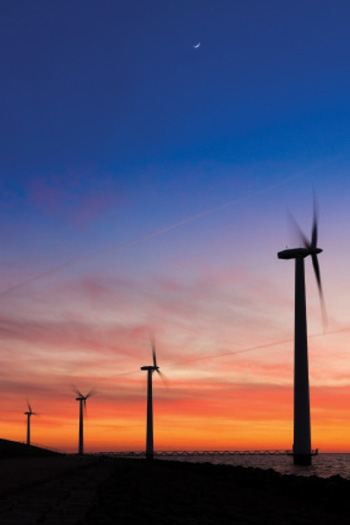2012 News & Events
CSD Paper on Offshore Wind Technology Among the Year's Ten Most-Read Papers in JAMC
26 October 2012
A paper by CSD's Yelena Pichugina and coauthors in our Atmospheric Remote Sensing group is among the ten most widely read papers during the past 12 months in the Journal of Applied Meteorology and Climatology, a journal of the American Meteorological Society. "Doppler lidar–based wind-profile measurement system for offshore wind-energy and other marine boundary layer applications" describes a Doppler lidar–based wind measurement system for use in the marine environment. Of special interest is the application of this system to the development of offshore wind energy, where knowledge of wind speeds at the height of the blades of wind turbines is necessary. The University of Colorado CIRES Spheres Magazine recently ran a story about the paper:
Investigating the unknown: offshore wind at the heights of modern wind turbines

The sort of wind that tosses around a person's hair and upends umbrellas just doesn't cut it for wind energy producers. They're not interested in ground-level winds.
Rather, energy producers want to understand what's going on 100 meters (about 330 feet) or higher in the air – the heights of modern wind turbines.
Unfortunately, scientists' understanding of these higher-up winds – which can whip in a different direction than surface winds or blow stronger or weaker – is limited. Few studies have focused on wind patterns at these heights, especially over the ocean. That's a problem because offshore is where many energy experts envision wind farms in the future.
Yelena Pichugina, working with CIRES and NOAA colleagues, has figured out how to capture detailed portraits of those elusive turbine-height winds, both onshore and offshore. Pichugina used NOAA high-resolution Doppler lidar measurements to track these high-blowing winds' behavior. Doppler lidar instruments send out laser beams that bounce off aerosol particles in motion. Sensors pick up the reflected laser light, giving researchers information about the direction and speed of the wind.
"We show that Doppler lidar is a powerful tool for understanding offshore winds at turbine height," Pichugina said. She hopes the concept may eventually help wind energy developers faced with tough decisions about where to deploy wind farms offshore.
In 2004, a NOAA-led research team installed a Doppler lidar on a ship in the Gulf of Maine, to make wind measurements in support of a New England air quality research project. A unique motion compensation system, developed by NOAA's Alan Brewer and his engineer colleagues, let the device capture exquisitely detailed measurements of shifting winds.
Post-analysis of the data showed consistent differences between night and day wind speeds and directions, and revealed how quickly winds could shift—an important factor in wind energy production. The scientists also identified wind patterns that were due to the shape of the coast itself, and differences between near-shore areas and those farther out—information that could be critical for siting wind farms.
Pichugina said there are many similar data sets, from offshore and land studies, that could help researchers better understand winds at the height of modern wind turbines. It takes time and effort to extract that information—finding the full data sets, quality-checking and analyzing data—but that's far cheaper than the alternative of collecting new data, especially offshore.
"You can imagine the challenges in making wind profile measurements in the marine boundary layer," Pichugina said. On land, a scientist might install instruments on a tall tower, but to build a tower in the ocean is expensive. And like tall towers on land, measurements made in one spot over the ocean would only provide information about only one relatively small region.
As wind farms continue to expand, it becomes even more important to move beyond using surface measurements to estimate wind behavior at turbine height. CIRES and NOAA scientists hope to address this issue by continuing detailed analysis of unique existing data sets of lidar wind measurements.
Their hopes are to supply a more relevant indicator of wind behavior than simply another bad-hair day.
Pichugina, Yelena L., Robert M. Banta, W. Alan Brewer, Scott P. Sandberg, R. Michael Hardesty, Doppler lidar–based wind-profile measurement system for offshore wind-energy and other marine boundary layer applications Journal of Applied Meteorology and Climatology, doi: 10.1175/JAMC-D-11-040.1, 2012.
Abstract
Accurate measurement of wind speed profiles aloft in the marine boundary layer is a difficult challenge. The development of offshore wind energy requires accurate information on wind speeds above the surface at least at the levels occupied by turbine blades. Few measured data are available at these heights, and the temporal and spatial behavior of near-surface winds is often unrepresentative of that at the required heights. As a consequence, numerical model data, another potential source of information, are essentially unverified at these levels of the atmosphere. In this paper, a motion-compensated, high-resolution Doppler lidar–based wind measurement system that is capable of providing needed information on offshore winds at several heights is described. The system has been evaluated and verified in several ways. A sampling of data from the 2004 New England Air Quality Study shows the kind of analyses and information available. Examples include time–height cross sections, time series, profiles, and distributions of quantities such as winds and shear. These analyses show that there is strong spatial and temporal variability associated with the wind field in the marine boundary layer. Winds near the coast show diurnal variations, and frequent occurrences of low-level jets are evident, especially during nocturnal periods. Persistent patterns of spatial variability in the flow field that are due to coastal irregularities should be of particular concern for wind-energy planning, because they affect the representativeness of fixed-location measurements and imply that some areas would be favored for wind-energy production whereas others would not.